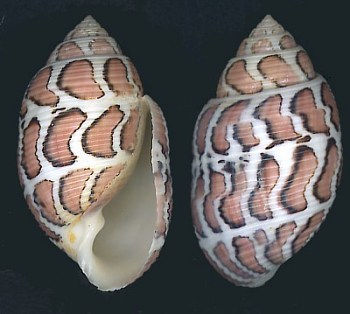
Acteon eloiseae
Abbott, 1973
Order: CEPHALASPIDEA
Superfamily: ACTEONOIDEA
Family: Acteonidae
DISTRIBUTION
Known only from Al Masirah Id, Oman, Arabian Sea
PHOTO
Shell presented to the Australian Museum by Dr D. Bosch and his wife Eloise after whom the species is named. Shell 32mm in length. Al Masirah Id, Oman, Arabian Sea. Scanned image: Bill Rudman
Acteon eloiseae is known only from Al Masirah Id, Oman, Arabian Sea. The largest shell known is 38mm long. Nothing is known of its anatomy so a generic placement is not possible but as Abbott suggests it closely resembles species of the genus Maxacteon and in particular Maxacteon flammea. It is often misspelt A. eloisae.
Reference:
• Abbott, R.T. (1973) Acteon eloiseae, a new opisthobranch from Arabia. The Nautilus, 87(4): 91-92.
Rudman, W.B., 2001 (April 22) Acteon eloiseae Abbott, 1973. [In] Sea Slug Forum. Australian Museum, Sydney. Available from http://www.seaslugforum.net/find/acteeloi
Related messages
Re: Natural history of Acteon eloiseae
October 13, 2005
From: Mark Seward
Shelley
Concerning your message #4216:
If it is of any use to you, I lived on Masirah Island for 5 years and naturally ended up (as an enthusiastic and amateur shell collector) with a couple of the Acteon eloiseae shells, and a large variety of assorted Cowries and Cymatium. The "eloise" are peculiar to one beach area on the island only - a place called Sur Masirah approximately half way down the west side of the island. I found them on sand in water filled tidal gullies near the low water mark, normally living in or near sea grass, and in an area populated also with olive shells. Unfortunately just before I left the island in 1993, the breeding area of the shells had been witnessed being "hoovered" and a very large quantity of the "eloise" had been removed live. Additionally the indigenous population had cottoned on to the fact that people desired this shell, and they started indiscriminately removing live shells also to try and sell.
Hoping this may be of some use. If you would like any other info. please do not hesitate to contact me here in Saudi Arabia.
Locality: Sur Masirah Id. Sultanate of Oman, Arabian Sea. Depth: Surface or to 1 ft. Length: 25 - 35 mm. 1989 - 1993. Sandy bottom, sea grass in gullies. Photographer: Mark Seward
Mark Seward
kelpinksa@yahoo.co.uk
Seward, M., 2005 (Oct 13) Re: Natural history of Acteon eloiseae. [Message in] Sea Slug Forum. Australian Museum, Sydney. Available from http://www.seaslugforum.net/find/15000Thanks Mark,
Best wishes,
Bill Rudman
Natural history of Acteon eloiseae
April 24, 2001
From: Shelley Hanson
I am trying to find any information on the Eloise Acteon's behavior. It doesn't seem to be included in this list. At least, I was not able to find any information on this species. If possible, could anyone tell me if this mollusk behaves the same as other bubble mollusks? Does it expel the contents of its stomach before retreating into its shell? Is it also a hermaphrodite? If it is on this list, and I couldn't find it because I have erred in the classification, I apologize.
Thank you for any assistance you can provide.
Sincerely,
Shelley Hanson
chezfluffy@aol.com
Hanson, S., 2001 (Apr 24) Natural history of Acteon eloiseae. [Message in] Sea Slug Forum. Australian Museum, Sydney. Available from http://www.seaslugforum.net/find/4216Dear Shelley,
I have just made an Acteon eloiseae Page since I knew we had a specimen in the collection donated by Dr Bosch and his wife Eloise, after whom the species is named. I am afraid we know nothing about the living animal other than it has been found only at Al Masirah Id, off the coast of Oman, Arabian Sea. I would agree with Tucker Abbott's comments in his original description that it very similar to Maxacteon flammea and it is much more likely that it will turn out to be a Maxacteon than an Acteon.
From my studies of living Pupa and Maxacteon I would guess that A. eloiseae is a shallow burrower in sand or sandy mud, and almost certainly feeds on polychaete worms. In my experience, very few Bubble Shells regurgitate their food unless they are being plunged into some nasty liquid like alcohol or formalin. Species of Philinopsis are the only Bubble Shells I know that regularly regurgitate their prey naturally. They feed on other Bubble Shells, and tend to regurgitate the whole shells of their prey after they have digested out the animal - probably less painful than sending it out via the intestine.
Concerning their sexual inclination. All opisthobranchs are hermaphrodite. The few acteonids that have been studied seem to develop the male part of their system before the female part - a process called protandry. I would be interested to know why you are interested in this particular species. Have you been attracted by its beautiful shell, or have you found it living somewhere?
One last note. I note you spelt its name 'eloisae' and on checking through the web I see it is often misspelt this way. The spelling used by Abbott was 'eloiseae'.
Best wishes,
Bill Rudman
